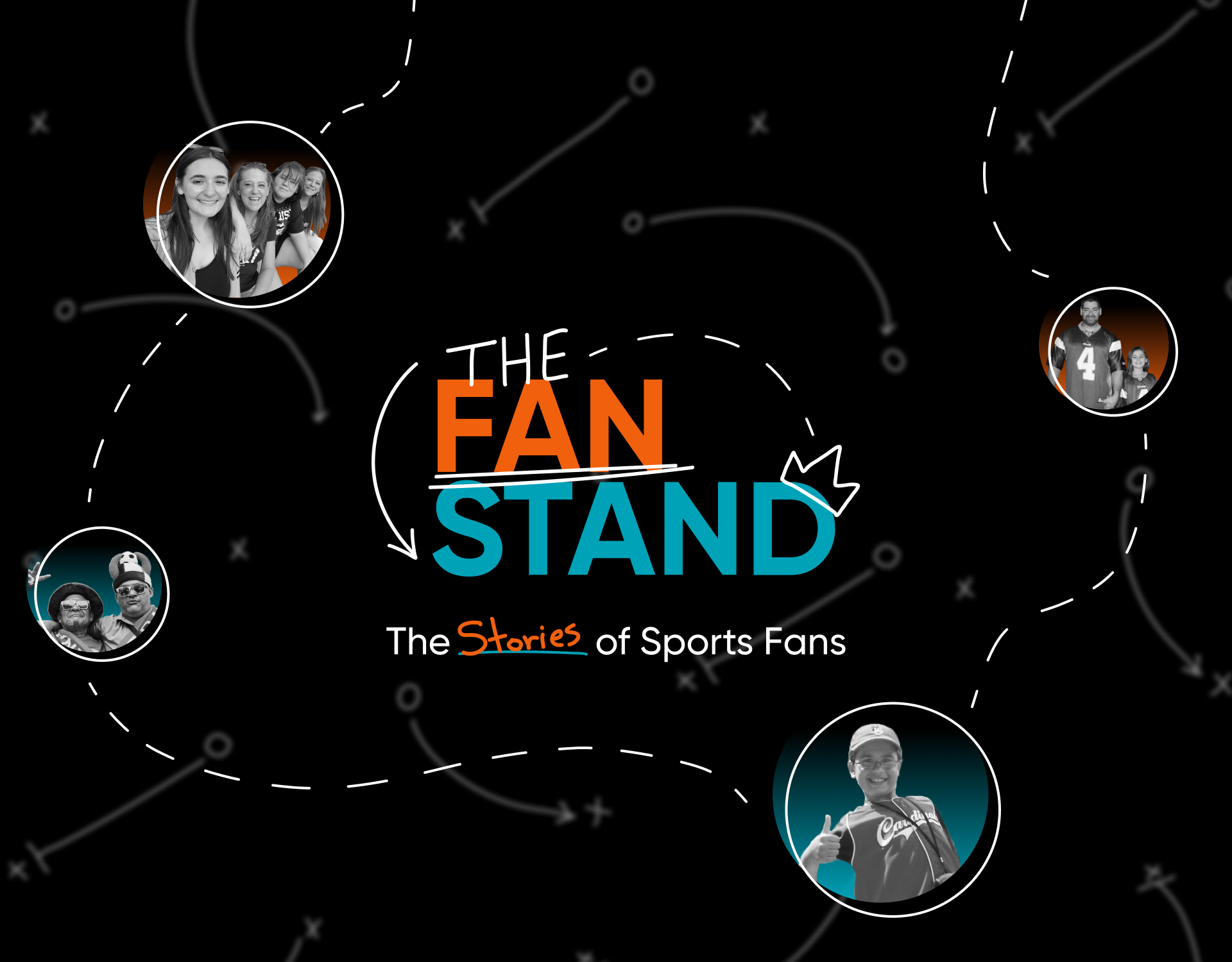
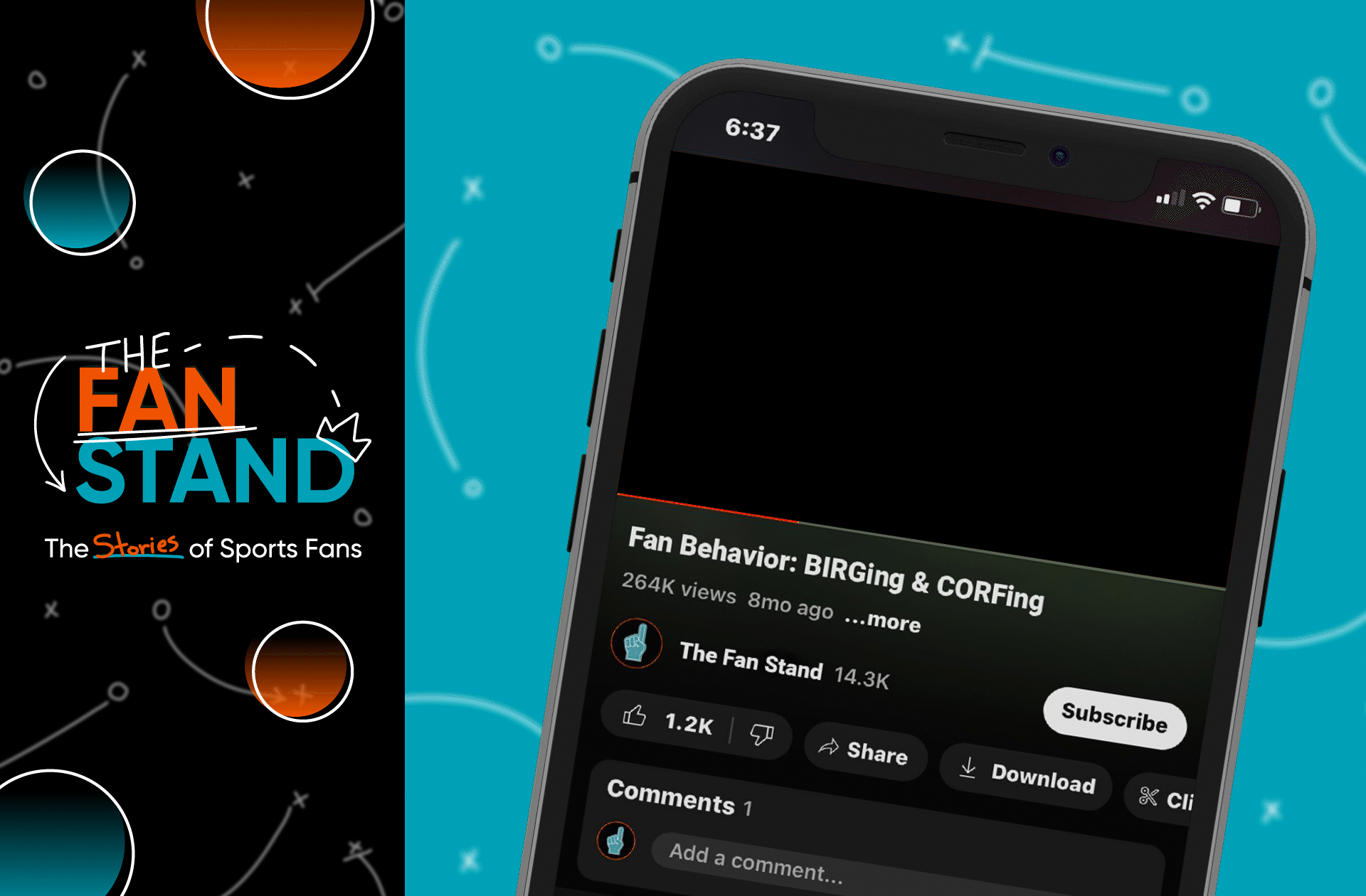
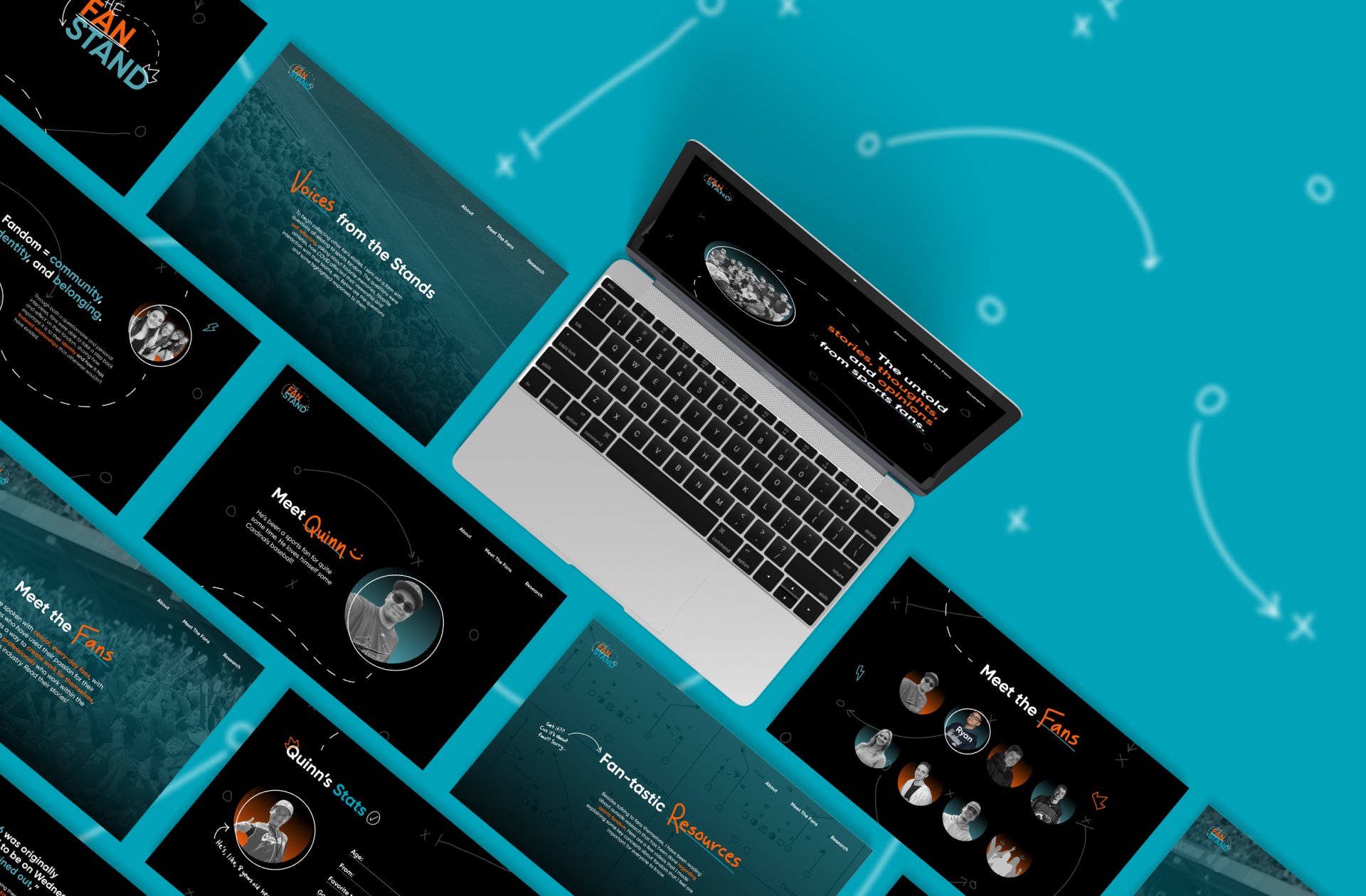
Senior Thesis Project
The Stories of Sports Fans
The Fan Stand is a project that puts the spotlight on the passionate fans that make major league team sports what they are. These fan's stories become heard, showcasing the feelings of community, identity, and belonging that occur because of their fandom. Through both personal interviews and submissions from fans around the country, the website presents how sports fandom can positively impact a person’s life. In addition to these stories, a series of short, animated explainer videos cover research concepts regarding sports fandom, including different types of fan behavior and why they happen.
A quick walkthrough video of the prototype if you don't feel like exploring it yourself. :)
"BIRGing and CORFing" - An explainer video about types of fan behavior and why they happen.
2024 Design Show

My full design show set up.

Me explaining my project to people passing by at the show.

Closer view of the screens within my set up.

Closer view of main screen and my handouts (stickers and mini foam fingers).

Me standing at my table at the show.

Me explaining my project to people passing by at the show.

Sticker design that I gave out at the show

Mini foam fingers that I gave out at the show
At the end of the spring semester, all of the design students working on their thesis projects were part of the 2024 Design Show where they were able to showcase their projects at their own display tables. I also was part of the design team that branded the show for this year, which you can find on this page!
Here is my process book, you can take a look through there or scroll through the rest of this page to see my process. It's a bit of scrolling though, so it's up to you!
F.Y.I. the process book goes into more detail about the process if you're super duper interested, but the rest of this page covers pretty much everything too. :)
Process
Choosing the Topic
I’m originally from northern NJ and growing up in that area makes it
difficult to avoid sports, so I’ve loved sports my entire life. I consider
myself a very passionate fan, with my life revolving around my favorite
teams. My time at SUNY New Paltz has exposed me to people who
haven’t grown up around sports like I have, and I witnessed the
negative stereotypes they had around sports fans. So, I decided to
make a project dedicated to showing the real fans and the ways sports
have positively impacted their lives.
However, it did take some time for me to fully realize this is what I wanted the project to become and my topic had a bit of an evolution along the way.
difficult to avoid sports, so I’ve loved sports my entire life. I consider
myself a very passionate fan, with my life revolving around my favorite
teams. My time at SUNY New Paltz has exposed me to people who
haven’t grown up around sports like I have, and I witnessed the
negative stereotypes they had around sports fans. So, I decided to
make a project dedicated to showing the real fans and the ways sports
have positively impacted their lives.
However, it did take some time for me to fully realize this is what I wanted the project to become and my topic had a bit of an evolution along the way.
Research - Fluid Fandom

The Fluid Fan is here - Sports Innovation Lab research report
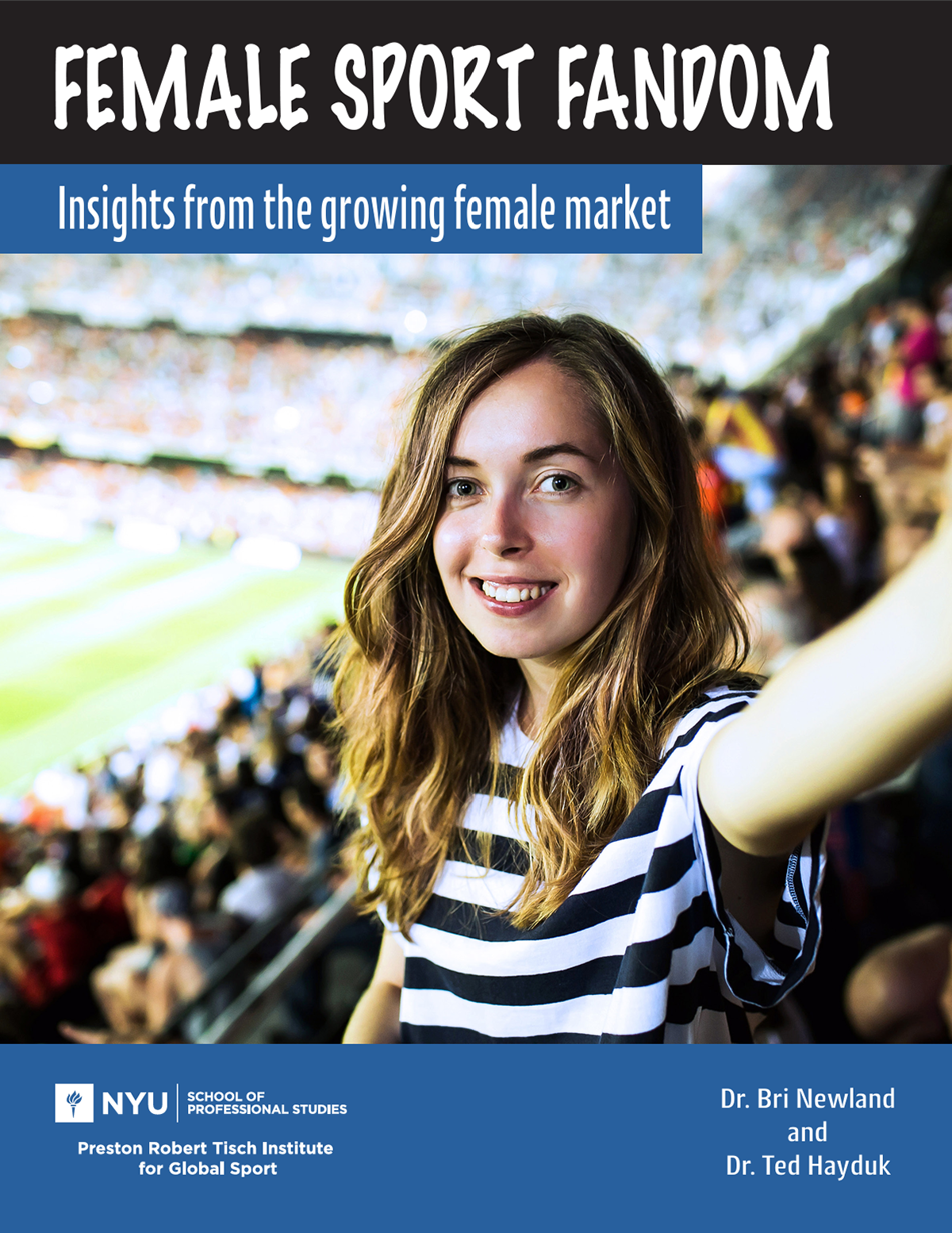
Female Sports Fandom - NYU research report

The Fluid Fan Podcast - Spotify podcast from Sports Innovation Lab
While I knew I wanted to focus on sports, I wasn't certain specifically what the topic would be in the early days of my research. I discovered this new sports fan behavior phenomenon given the name “Fluid Fans” by Sports Innovation Lab that really sparked my interest. The phenomenon relates to team loyalty as well as how fans are evolving alongside technology. I continued researching fluid fandom and gathered a lot of resources about fan loyalty and fandom in general, wanting to create a project about the current evolution sports fandom is going through because of the pandemic and rise of on-line spaces.
Thesis Party
It was time to party a little bit, so I gathered some friends and family together and asked them questions about their sports experiences and their opinions on questions relating to fluid fandom. I was very invested in this fluid fan phenomenon and was curious to hear what they thought about it, especially my mom and aunt who are part of an older generation of sports fans who didn’t grow up with all of this technology that was vital to the fluid fan experience.

Family and friends at my thesis party!

Group photo before everyone responded to the questions set up on the table.

Table set up with questions that each person responded to.
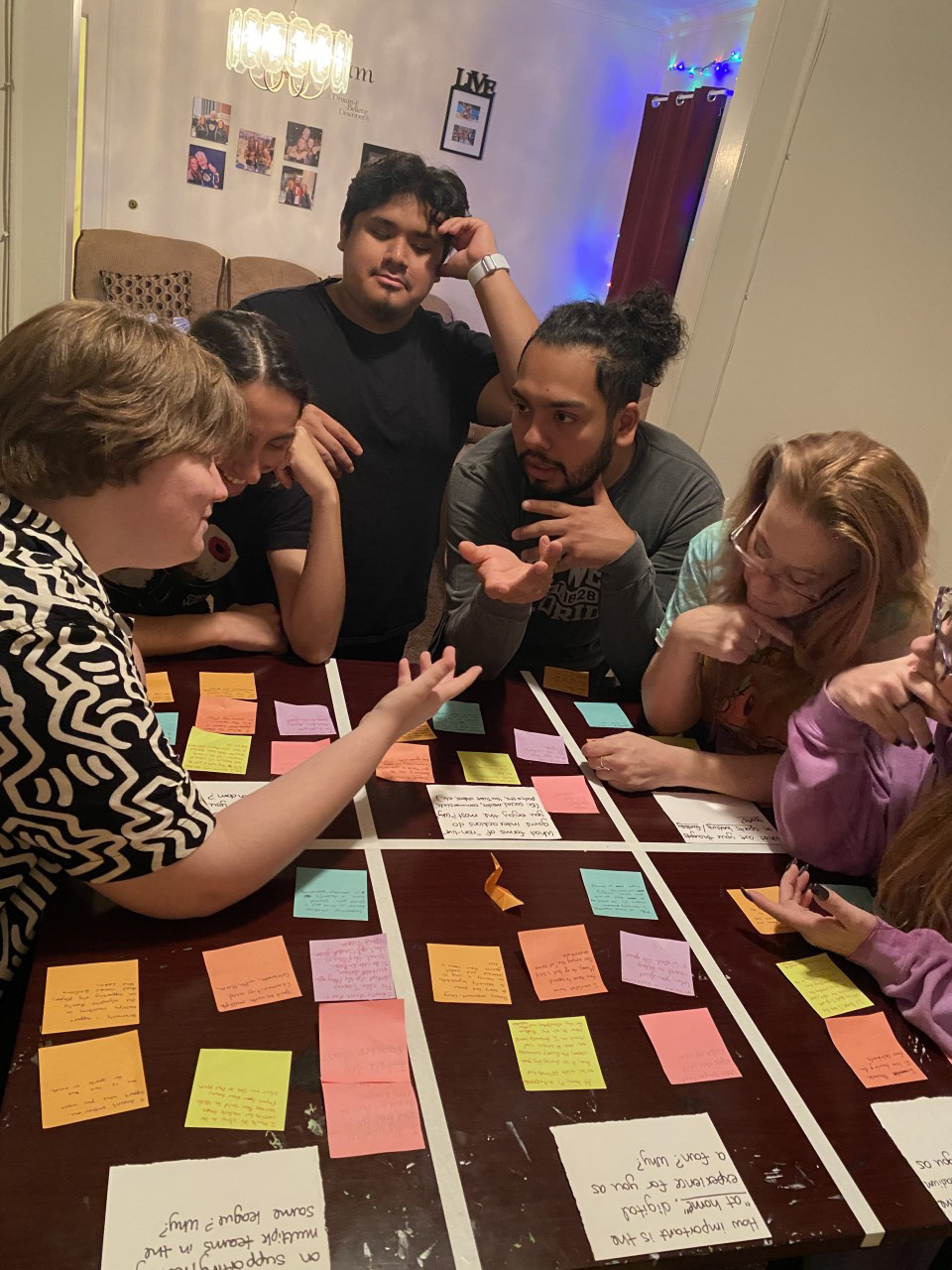
Everyone discussing their answers to the questions.
As we went through all of the questions I had planned, though, I began to realize I was getting much more enjoyment out of talking to them about their general sports experiences and stories rather than trying to teach them about a concept. This was the moment I started to question if I should switch gears a bit for my project’s focus.
Research - Benefits of Sports Fandom

Cover of Fans Have More Friends - By Ben Valenta and David Sikorjak

Cover of FANS - By Larry Olmsted

Cover of Sportista - By Andrei S. Markovits & Emily K. Albertson

Cover of The I In Team - By Erin C. Tarver
I was able to find many books in our campus library that focused on sports fandom and the social and health benefits is brings to people.
I truly enjoyed reading all of those books, especially Fans Have More Friends. However, this book specifically made me finally realize I did not want to do a research-heavy project.
Fans Have More Friends was a healthy mix of personal sports stories and research, and just like at my thesis party I noticed how much more enjoyment I felt while reading the stories compared to reading the research and statistics. So, I finally made the decision to pivot my focus to the fans. I wanted to talk to them and hear their stories, share laughs and bond through our hared love of sports. So, that’s what I did.

Bar graph in Fans Have More Friends

My notes in Fans Have More Friends

More of my notes in Fans Have More Friends
Development
The Stories of Sports Fans
Now that I knew I wanted to hear from fans themselves and talk to them personally, I began the process of reaching out and collecting the things fans had to say.
Click here to fill out the form, I'd love to hear from fans still!
Google Form
To reach out to as many fans as possible as quickly as possible, I created a Google form to send out on-line where I asked questions about their favorite teams, athletes, and memories, as well as thing like what benefits they’ve noticed personally, how important community building is to them as a fan, etc. At the end of the form I asked them to leave their email if they were interested in doing an interview with me to dive deeper into their answers. From there, I scheduled 6 interviews that I did over winter break, and 1 after coming back from break.
Note: This photo is not the whole form, there is a total of 13 questions.
Interviews

Me interviewing my friend Ryan on Zoom.
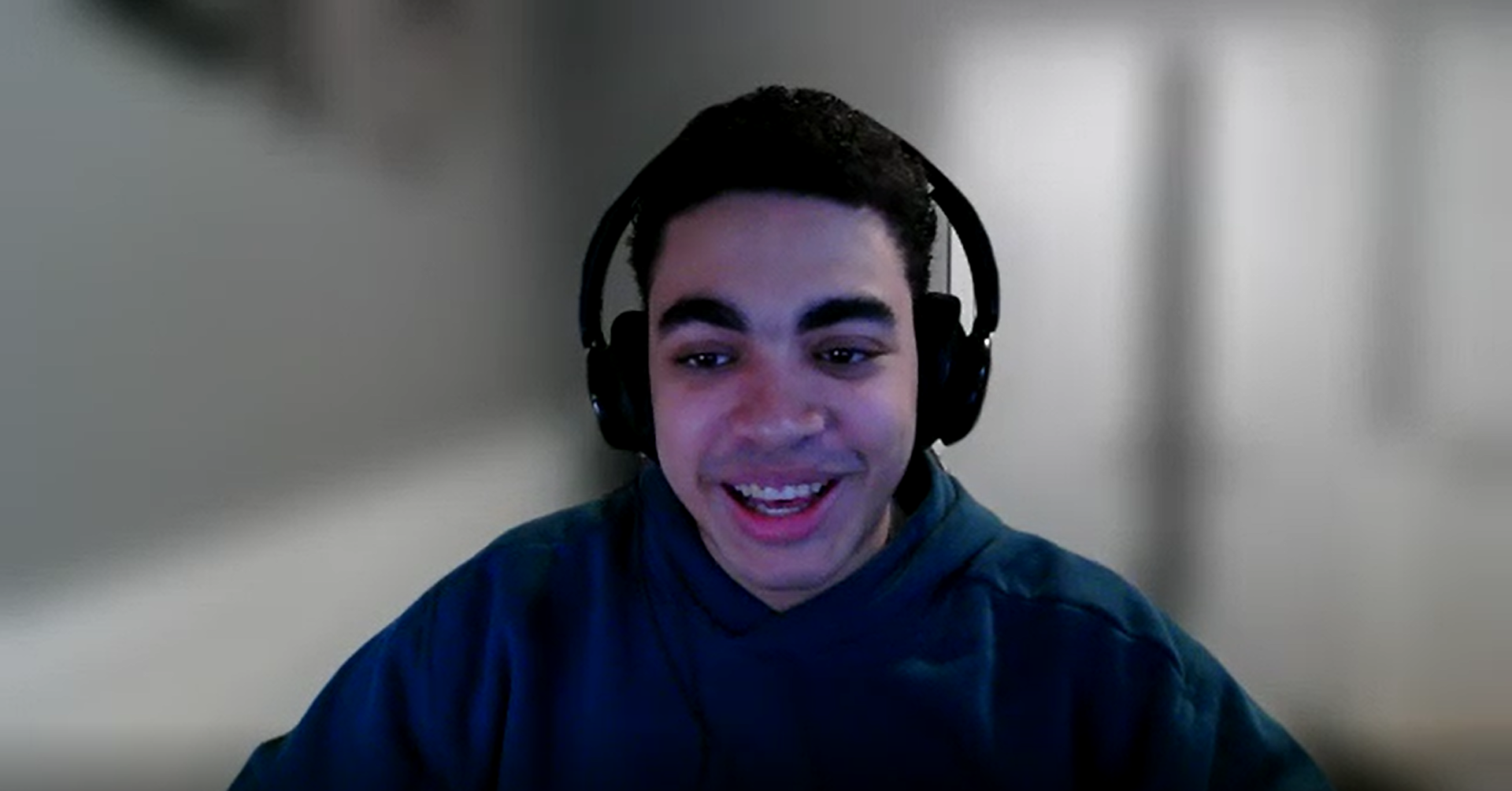
My friend Ryan on Zoom.

Me interviewing Lisa on Zoom.

Lisa on Zoom.
I had gathered a list of 7 people who agreed to do interviews with me, which was amazing! I did not expect that many people to agree, but it was great seeing how excited they all were to talk to me about their fandom. Based on each person's form responses, I curated questions specifically for them as well as repeated questions throughout all of the interviews that I felt were important to cover. While not all 7 interviews are implemented into the final prototype, they are all transcribed and will eventually be added!

Example of transcript 1. The highlighted portions are what I'd include on the website.

Example of transcript 2. The highlighted portions are what I'd include on the website.
Development
Visual Language
Back pedaling a little bit, in order to release the Google form I needed some sort of visual language to use. I couldn’t just send out a QR code, I had to make some fun posters/social media graphics. At this point I did not have a developed visual language for my project, so I used this as an opportunity to test things out like colors, typography, imagery, etc.
Pecha Kucha

Pecha Kucha slide

Pecha Kucha slide

Pecha Kucha slide

Pecha Kucha slide
This ended up not being what I chose for the final project, but elements from it did make their way to the final in some shape or form. They were still enjoyable to make and people reacted well to them, I got 26 submissions. I also used this visual direction for the Pecha Kucha presentation (exactly 4 minute presentation to explain the in-progress project at that moment) that served as our midterm check-in. The visual language never felt right, it was a bit too playful and loose. I needed to tighten things up.
Drafting
I began experimenting with different colors, fonts, logo designs, and
more to see if anything would stick. For a while, I was having a hard
time thinking about what I really wanted the website to look like. I
wasn’t enjoying any of the color choices I was making, none of the
fonts felt right, and everyone I showed the logos to had different opinions
so I wasn’t sure which I wanted to use.
more to see if anything would stick. For a while, I was having a hard
time thinking about what I really wanted the website to look like. I
wasn’t enjoying any of the color choices I was making, none of the
fonts felt right, and everyone I showed the logos to had different opinions
so I wasn’t sure which I wanted to use.

Style Tile 1

Style Tile 2

Logo exploration

Type exploration
Development
Building The Site
I needed to put the visual language development on pause and start thinking about the site itself; the layout, the navigation, and all of that important stuff. I kept telling myself that the visuals will come to me eventually. So, I started layout out the site’s structure instead.
Organizing & Ideating

Affinity Diagram

Card Sorting/Structure

Persona 1

Persona 2
Wireframing

Wireframe sketches - Home & About pages

Wireframe sketches - Meet The Fans & Individual fan pages

Wireframe sketches - Form Responses page
Early low-fidelity wireframe sketches
Mid-fidelity wireframes of homepage

Homepage wireframe draft 1

Homepage wireframe draft 2

Homepage wireframe draft 3
Drafting - Website
I'm glad I decided to take a break from the visual language and say "it'll just come to me later" because that's exactly what happened. After a few weeks of not thinking about it, it was finally time to jump back into it and I almost immediately found something that I enjoyed. The blue and orange were colors I had thought about very early in the design process because they are less associated with specific major sports teams compared to colors like red or green. While there are blue and orange teams, these colors together didn't immediately make people think of a team but still felt "sporty" in context with everything else. I showed these drafts to multiple people, sports fans and non-fans, and they agreed.
These are all some of the drafts of the homepage, as I just wanted to figure out fonts, type treatment, colors, and other visual elements first before getting into the rest of the pages.

Homepage draft 1

Homepage draft 3

Homepage draft 8

Homepage draft 10
Drafting - Animated Explainer Video
At the same time of drafting the website, I was working on developing the explainer video that I planned to voice over and animate. I didn't want to let my research on fan behavior go to waste, as I felt it was still useful information, so I added a section to the site where I would be uploading these videos explaining different concepts relating to sports fandom. I would be writing the scripts, voicing them over, and animating them myself.
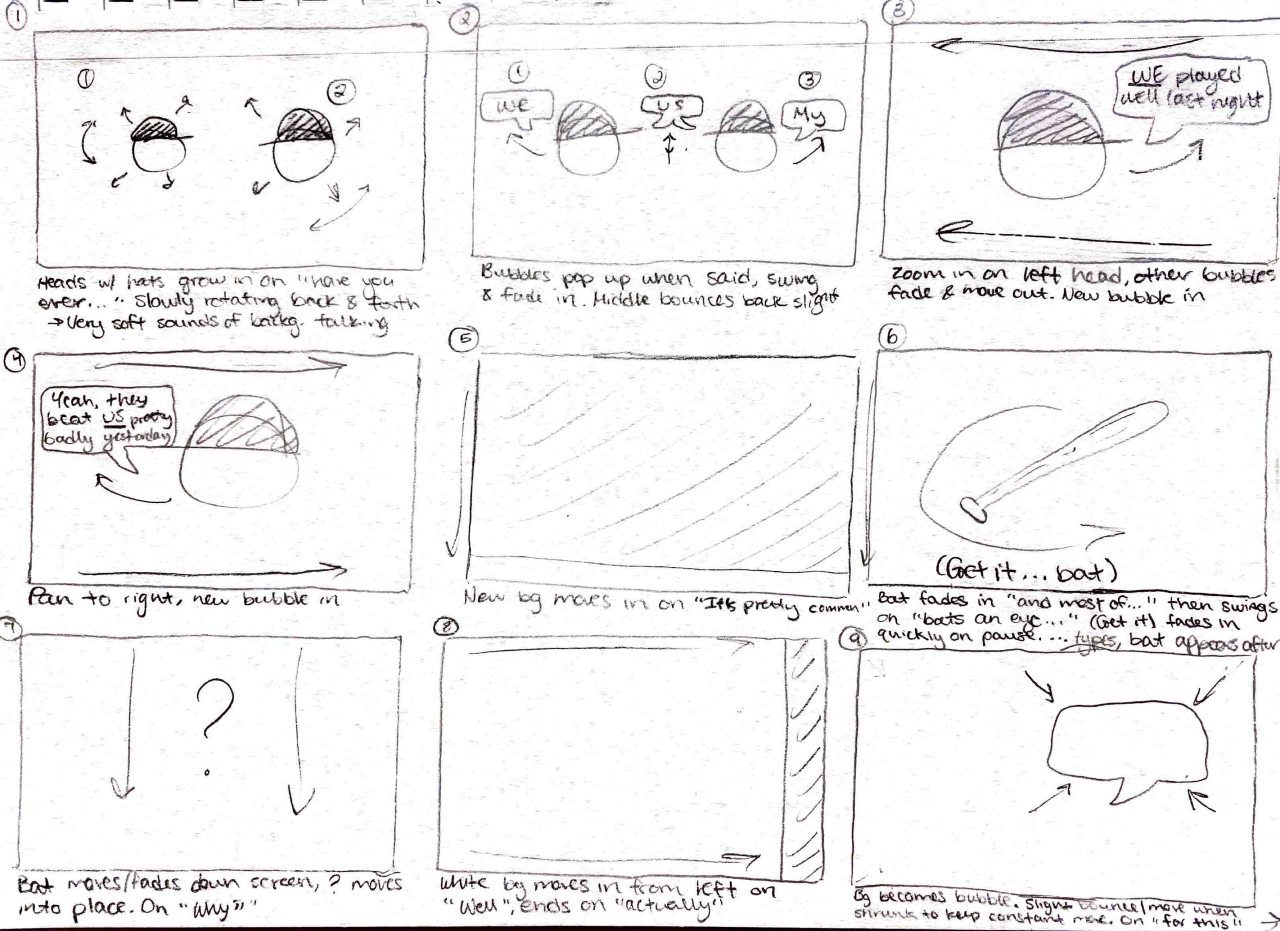
BIRGing video storyboard 1

BIRGing video storyboard 2

BIRGing video storyboard 3

BIRGing video storyboard 4

BIRGing video storyboard 5
Sketched storyboards for "Fan Behavior: BIRGing & CORFing" explainer video.
Style boards for "Fan Behavior: BIRGing & CORFing"
explainer video.
explainer video.
Now that I had a visual language figured out I was able to create style boards for the video as well.






The End
Reflections
This project has taught me a lot about myself as a designer. I learned
how obsessive I can become over the smallest details that, honestly,
99% of people wouldn’t notice anyway. Especially in the last two weeks
before the show, I learned how to better prioritize what I should focus
my attention on, the “minimum viable product” as my professor called it.
Obviously, you want to go above and beyond, especially for a project
this personal and this long-term, but at the end of the day you can only
do so much and you need to just get it done.
how obsessive I can become over the smallest details that, honestly,
99% of people wouldn’t notice anyway. Especially in the last two weeks
before the show, I learned how to better prioritize what I should focus
my attention on, the “minimum viable product” as my professor called it.
Obviously, you want to go above and beyond, especially for a project
this personal and this long-term, but at the end of the day you can only
do so much and you need to just get it done.
The show was something I had stressed about since the summer before
Thesis I, but it was honestly one of the most fun days I’ve had in a long
time. Not only was it fun because I got to show off such a personal and
impactful project, but also seeing all of my friends and classmates
doing the same thing and all of us being proud of ourselves and of
each other was something truly special. The show was also a great way
for me to learn how to talk about my work in an understanding and
efficient way. After the first few people came to my table I basically had
my explanation down to a science, it was kind of scary and I felt like a robot.
I’m so grateful for all of the help I got from friends, family, classmates,
professor, and more along the way. I am also grateful for all of the
people who participated in the final project! I couldn’t have done it
without any of you. This was one of the hardest, most rewarding project I have ever worked on and I hope everyone enjoys it (almost) as much as I do.










